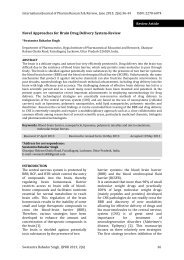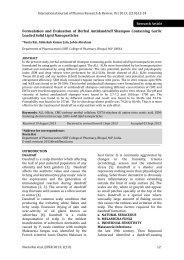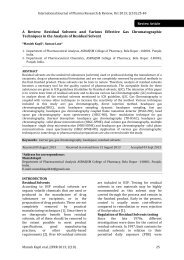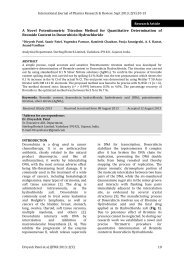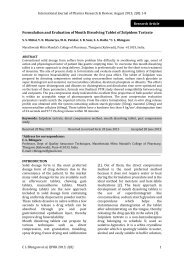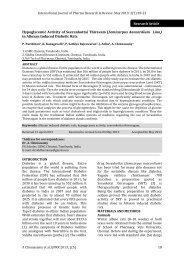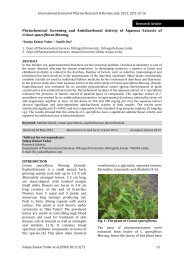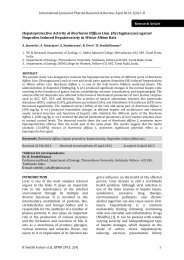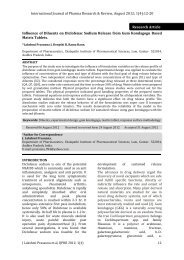International Journal of Pharma Research & Review, May 2013; 2(5 ...
International Journal of Pharma Research & Review, May 2013; 2(5 ...
International Journal of Pharma Research & Review, May 2013; 2(5 ...
- No tags were found...
You also want an ePaper? Increase the reach of your titles
YUMPU automatically turns print PDFs into web optimized ePapers that Google loves.
<strong>International</strong> <strong>Journal</strong> <strong>of</strong> <strong>Pharma</strong> <strong>Research</strong> & <strong>Review</strong>, <strong>May</strong> <strong>2013</strong>; 2(5):13-17It is known that non-steroidal antiinflammatorydrugs usually do not increasethe pain threshold in normal tissues,whereas local anesthetics and narcotics do.The acetic acid induced abdominal writheswere observed to be 40.44 ± 6.90 over theperiod <strong>of</strong> 10 min in the control. The number<strong>of</strong> abdominal writhes were not significantly(p>0.05) inhibited by KarunkaliverKudineer. Standard drug, acetyl salicylicacid significantly inhibited writhes by about73.04% over the control. The painprotective effect exerted by theKarunkaliver Kudineer on the mouse by hotplate method, suggest that the analgesiceffect <strong>of</strong> the drug may be centrally mediatedbut not peripherally. Acetic acid-inducedwrithing is a well recommended protocol inevaluating medicinal agents for theiranalgesic property. The pain inductioncaused by liberating endogenoussubstances as well as some other painmediators such as arachidonic acid viacyclo-oxygenase, and prostaglandinbiosynthesis.This pain paradigm is widely used for theassessment <strong>of</strong> peripheral analgesic activitydue to its sensitivity and response to thecompounds at a dose which is not effectivein other methods. The local peritonealreceptor could be the cause <strong>of</strong> abdominalwrithings. Pain sensation in acetic acidinduced writhing paradigm is elicited byproducing localized inflammatory responsedue to release <strong>of</strong> free arachidonic acid fromtissue phospholipids via cyclo-oxygenase(COX), and producing prostaglandinspecifically PGE2 and PGF2α, the level <strong>of</strong>lipoxygenase products may also increasesin peritoneal fluids. These prostaglandinand lipoxygenase products cause pain byincreasing capillary permeability. Thesubstance inhibiting the writhings will haveanalgesic effect preferably by inhibition <strong>of</strong>prostaglandin synthesis, a peripheralmechanism <strong>of</strong> pain inhibition. Thermalnociception models such as hot plate testused to evaluate central analgesic activity.Table 2: Effect <strong>of</strong> Karunkaliver Kudineer on pain induced by hot plate methodControlDoseReactiontime in sec.beforedrug% increase in reaction time after drug treatment30 min 60 min 90 min 120 minSaline 3.2±0.05 8.1±0.02 12.6±0.5 15.48±0.6 15.30±0.52 ml/kg1 ml/kg 3.2±0.04 19.6±0.32** 25.42±1.18** 37.25±2.23** 35.38±1.12**KarunkaliverKudineerKarunkaliver 2 ml/kg 3.1±0.05 27.2±0.30** 36.20±1.42** 55.39±2.81** 46.20±1.20**KudineerKarunkaliver 4 ml/kg 2.4±0.05 32.4±0.26** 39.56±1.33** 64.00±2.48** 53.18±1.20**KudineerPentazocin 5 mg/kg 3.0±0.04 54.1±1.33** 65.72±2.88** 69.10±2.45** 66.04±2.00*Values expressed in mean ±SEM, Significant **P




